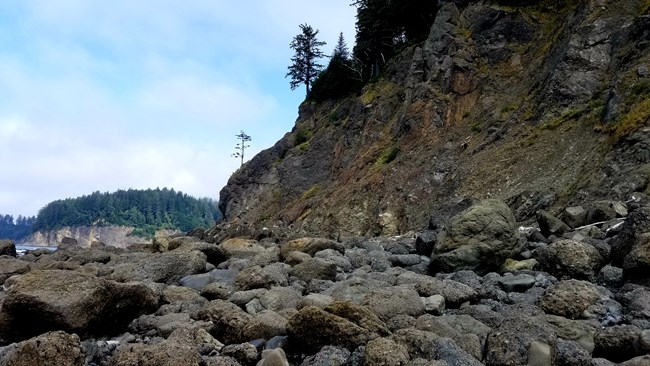Trail Guide
Coastal Hiking
Hiking the Olympic Coast is unique in that the routes for the most part follow the natural land features found along the shore. Overland trails aid hikers in navigating sections of the coast that are not feasible or safe to hike at shore level. Certain sections of coastal routes are also only passable at mid-to-low tides; these sections should be identified and planned out prior to a trip. Be advised that during certain tidal cycles the Diamond Rock tidal restrictions approximately 1.5 miles north of Oil City will not become passable for entire days on end. The terrain along the coast is variable and a number of conditions under foot will be encountered including but not limited to - fine sand beaches, pebbly/rocky beaches, slippery moss/algae covered boulders, driftwood logs, rocky headlands, rope & ladder assisted overland trails, forested and brushy overland trails and sections of well-maintained trails.
Third Beach Trailhead ⇒ Third Beach
~1.4 miles
The trail begins by meandering through coastal forest until reaching the 200' decent down to the beach. Driftwood logs often have to be negotiated in order to reach the sand. Distant views of Giants Graveyard offer a striking backdrop to the south. Neither Teawhit Head or Taylor Point can be rounded at shore level. A privy is located up a short side trail on the south side of the creek.
Third Beach ⇒ Scott Creek
~2.6 miles
Continue south along Third Beach. Erosion of the coastal bluff has pushed debris down onto the beach and can be a barrier that must be negotiated during high tides. Taylor Point is impassable at sea level and must be bypassed via an overland trail. The overland trail takes off from the southern end of Third Beach and uses a series of low angle ladders and ropes to aid hikers up the slippery slope. The trail remains in the forest for the next 1.25 miles before another rope and ladder lead back down to a small, rocky cove which maybe be under water with a tide greater than 4.5' (a short, steep and loose overland trail provides access around this short point). Traverse the pebbly beach to Scott's Bluff, where another short rope assisted overland trail goes up and around the small rocky point to Scott Creek. Three small campsites are situated above the beach amongst the driftwood logs. No privy is currently available at Scott Creek and finding a suitable area to dig a cat hole in this area can be difficult.
Scott Creek ⇒ Toleak Point
~2.4 miles
This section of the coastal route stays at sea level the entire way out to Toleak Point. A tidal restriction is located south of Scott Creek and is passable with a tidal level of 4' or lower and extends around the arching beach leading to Strawberry Point. Giants Graveyard, a large collection of sea stacks and islands, is situated just offshore and provides excellent habitat for resident seals and coastal seabirds. A prominent campsite resides at Strawberry Point and from this point on extending all the way around Toleak Point many well-established social trails and campsites are found situated amongst the forests edge just in from the beach. A privy is located in the forest on the north side of Toleak Point. Jackson Creek enters the ocean just south of Toleak Point and is the areas closest reliable water source.
Toleak Point ⇒ Mosquito Creek
~4.6 miles
A mile of sandy beach is encountered south of Toleak Point before a 1.5 mile overland trail enters the forest to avoid the impassable cliffs and mount of Goodman Creek. Falls Creek and Goodman Creek come in succession and are both fords. Higher tides may push ocean water up into Falls Creek at the crossing and make the ford thigh-to-waist deep during these times. Goodman Creek is usually ankle-to-knee deep under normal conditions. Once back on the sand south of Goodman Creek at mid-to-low tide a lovely 2.2 mile stretch of beach walking leads to Mosquito Creek. Mosquito Creek is another ford and the crossing should be done at mid-to-low tide. Four main campsites and a privy are situated within close proximity of one another a short distance up the overland trail on the bluff heading south from Mosquito Creek. There is limited camping on the shoreline near Mosquito Creek, especially during higher tides.
Mosquito Creek ⇒ Oil City Trailhead
~6.1 miles
The 3.5 mile overland trail from Mosquito Creek to Jefferson Cove is the longest overland trail on the coast and avoids the impassable bluffs and cliffs found at beach level south of Mosquito Creek. The trail through dense coastal forest is often overgrown and muddy. The weathered stairs and ladder leading down to Jefferson Cove can be slippery with unstable footing and caution should be used. Just south of Jefferson Cove is the Diamond Rock tidal restriction. This tricky spot requires a tide of 2' or lower and passes around a prominent rocky point with cliffs entering the water. As previously mentioned, during certain tidal cycles this tidal restriction will not be passable for consecutive days on end. It is imperative to check a tide chart and plan your trip accordingly before attempting to enter or exit from Oil City. The mouth of the Hoh River is reached after 2 miles south of Jefferson Cove. The Hoh River cannot be forded and the south side of the river is Hoh Tribal Land. Campsites exist in the driftwood logs above the beach and a trail takes off along the river leading .6 miles to the Oil City Trailhead.






